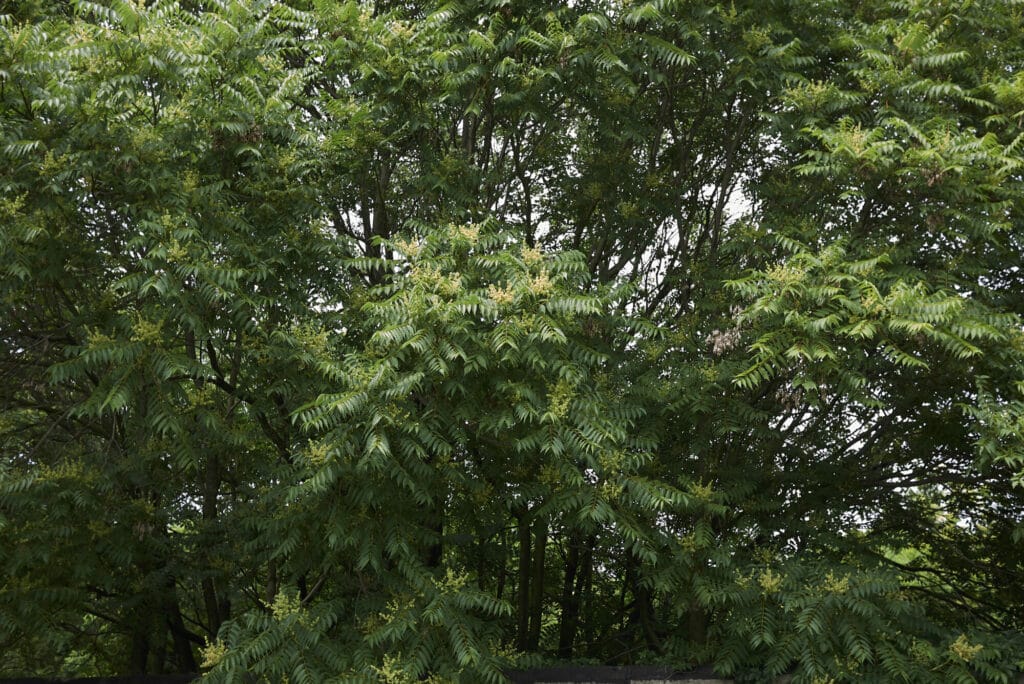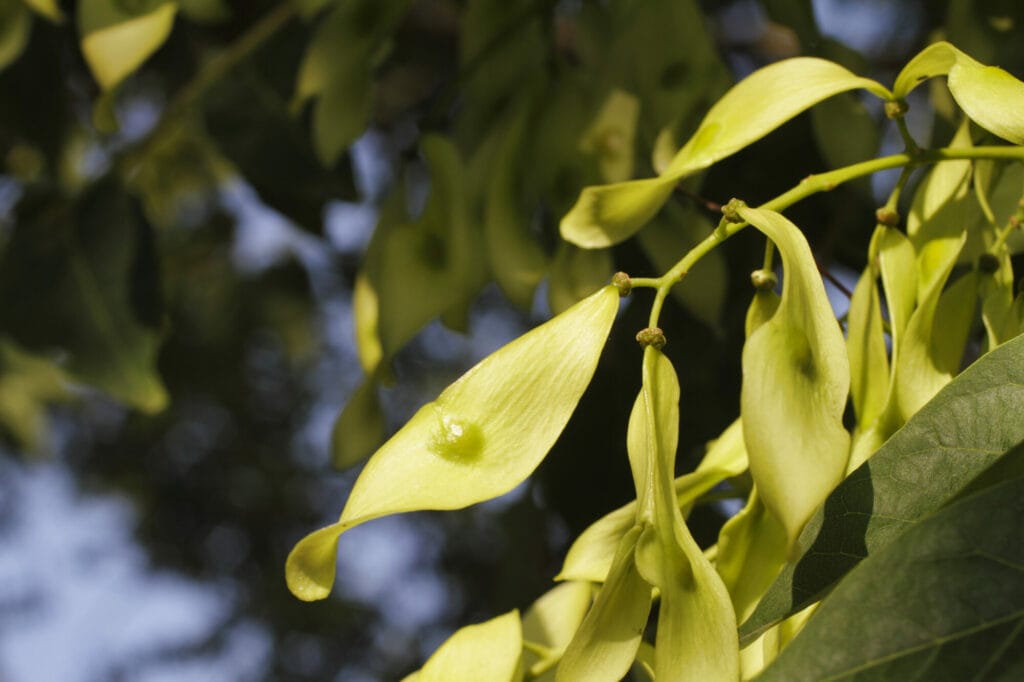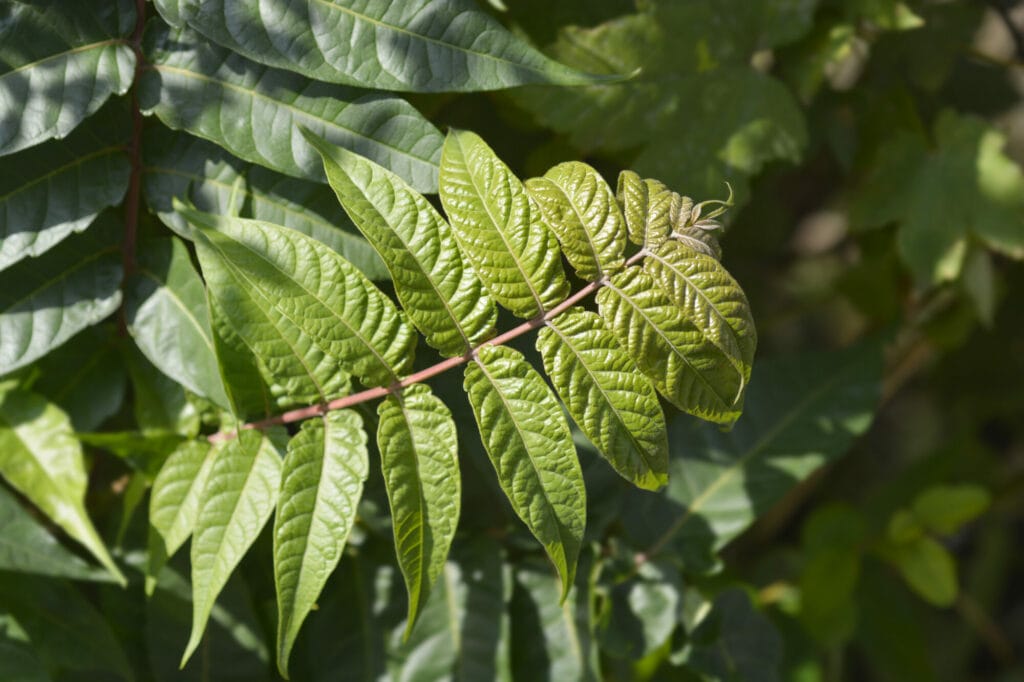Despite its misleading name, the Tree of Heaven (Ailanthus altissima), also known as Chinese Sumac, stink tree, varnish tree, and ghetto palm, poses a significant concern to UK ecosystems. Early identification and removal of tree of heaven is now being more commonly sought as a solution to this growing problem.
So why is it called Tree of Heaven? Tree of Heaven, is known for its rapid growth, as it seemingly ascends to heavenly heights. Nonetheless, the impact of Paradise tree is anything but paradisiacal.
Tree of Heaven Ailanthus altissima
Originally from China, Tree of Heaven became popular in the UK’s South East during the 19th and early 20th centuries for its ornamental value. Although it arrived in the country in the 1750s, it wasn’t until 1935 that it was first spotted growing wild. Today, it’s mostly concentrated in and around London and the south, but constitutes a threat of spreading across the UK if not properly controlled.
Like other hardwoods such as ash, sumac, and walnut, a Tree of Heaven tree can establish itself within two decades. Initially prized for its attractive foliage, delicate flowers, and winged fruit, it has a darker side too. Similar to Japanese knotweed, Ailanthus altissima can regenerate quickly even when cut back, making it challenging to manage.

Ailanthus altissima tree in flower iStock/seven75
Is Tree of Heaven a hardwood?
Tree of Heaven is classified as a hardwood, and like most other hardwood trees it is deciduous, shedding its leaves in autumn. However, it stands out, when compared with other hardwood species, because of its speedy growth.
Its hardwood status has seen Ailanthus altissima used for various purposes in its native China. These uses include the making of tools, crates, furniture and for ornamental purposes. The drawback of its rapid growth is a wood with uneven texture, which often leads to cracks when dried for use. The resulting weak and non-durable material does little to promote the plant as one that is useful for cultivation in the UK.
Is Tree of Heaven a Sumac?
Tree of Heaven is sometimes referred to as ‘Chinese Sumac’ owing to its superficial resemblance to trees in the Sumac family (Anacardiaceae). However, it should be noted that it is not a true sumac.
While both species share characteristics as hardwoods, and can grow to impressive heights, they have distinct features. Both bear leaves with multiple leaflets along a single stem. However, sumac leaflets are serrated along the edges, whereas those of Tree of Heaven are smooth.
Sumac trees produce red, fuzzy, cone-shaped fruit throughout summer and autumn. In contrast, the fruit of Ailanthus altissima, known as samaras, transforms from green and pink to an orangey-brown in autumn.
Is the Tree of Heaven invasive?
Although not included in Schedule 9 of the Wildlife and Countryside Act 1981, Tree of Heaven is listed by the UK government as a ‘Species of special concern’. This classification stems from its pronounced invasiveness and ability to quickly gain a foothold and the thrive in UK environments.
Consequently, the UK government has imposed regulations on invasive plants of this type, including the Tree of Heaven. Engaging in activities such as importing, cultivating or selling the species within the UK is illegal, unless qualifying for an exemption.
In essence, Tree of Heaven’s invasive nature creates a significant challenge in the UK, necessitating regulatory measures to mitigate its impact.
Why is the Tree of Heaven a problem?
Like many other invasive species, Tree of Heaven outcompetes native vegetation, particularly in woodland areas. It employs allelopathy by releasing chemicals that hinder the growth of native species.
In urban settings, where Tree of Heaven has also become established, it can inflict damage on sewers, pavements, and foundations, although reports of such damage are currently limited in the UK, with most occurrences documented in Southern Europe and North America.
Central to the problem with invasive species is their reproductive capability. Tree of Heaven is no different: its seeds are adaptable to various soils and environmental conditions, enabling its persistent growth in urban areas, often through cracks in pavements and buildings. Moreover, Tree of Heaven produces copious amounts of seeds encapsulated within winged samaras or schizocarps, facilitating their dispersal over distances of up to 100 metres.

Close up of the winged seeds of tree of Heaven (Ailanthus altissima) iStock/Whiteway
While Ailanthus altissima reproduces more successfully in the warmer climate of South East England compared to more Northern parts of the UK, the prospect of rising temperatures suggests the potential for this plant to become a more prevalent concern across UK ecosystems in the future.
Tree of Heaven identification
In just 15 to 20 years, Ailanthus altissima can exceed 15 metres in height, often forming dense clusters that displace native vegetation, akin to other invasive species.
Each compound leaf of Ailanthus altissima typically comprises 11 to 30 leaflets, characterized by smooth edges and glandular teeth near the stem. Resembling the foliage of sumac or ash trees, Ailanthus altissima leaves are larger than ash and less hairy than sumac.

Close up of tree of heaven (Ailanthus altissima) leaves iStock/Nahhan
But what does Tree of Heaven look like? Flourishing particularly in warmer summers, Tree of Heaven is dioecious, bearing male and female flowers on separate plants. Initially resembling one another in spring with pyramid-shaped clusters of tiny flowers, the female blossoms mature into winged samaras during the summer.
Samaras, or schizocarps, are paper-like, winged fruits containing a small seed encased within flat, twisted wings, serving as propellers for dispersal. A mature tree can produce hundreds of thousands of seeds per yearAilanthus altissima fruit transitions from pink to an orange or tan colour during the autumn.
Notably, Ailanthus altissima bark is light grey with striations, giving a reptilian appearance to mature tree trunks. Beyond its physical attributes, Tree of Heaven plants emit an unpleasant odour reminiscent of rancid peanuts, a trait more commonly associated with male trees, in particular their flowers. Consequently, female plants prevail in urban areas, curbing reproduction and limiting the species’ invasive impact in such locales.
By understanding these characteristics—flowers, fruit, leaves, bark, and odour—we can better identify Tree of Heaven, aiding efforts in its management and control.
Tree of Heaven removal
Once identified, and the risks are understood, most seek advice on the removal of Tree of Heaven. The initial step involves cutting back and removing as much as possible to make it more manageable. Ideally, this should be done before the plant flowers to prevent seed production.
A sustainable approach to addressing the issue of removal is currently under development: biological control. The Centre for Agriculture and Bioscience International (CABI), in collaboration with the Biotechnology and Biological Control Agency (BBCA) in Italy, is researching the use of the eriophyid mite, Aculus taihangensis, as a biological control method for Tree of Heaven. Studies indicate that Aculus taihangensis can significantly damage Tree of Heaven seedlings and impact new growth.
Currently, applying a glyphosate-based chemical treatment to the freshly-cut stumps provides a more practical and achievable solution. This ensures absorption throughout the entire plant for effective control. However, a method of this type can be challenging to execute, and should be carried out by a professional with the appropriate training for this type of herbicide application.
If you are concerned that you’ve spotted Tree of Heaven, and require further assistance, please contact PBA Solutions today by calling 0203 174 2187 or 01202 816134.
Close up of the seeds & leaves of tree of heaven (Ailanthus altissima)
Lead image iStock/vili45

